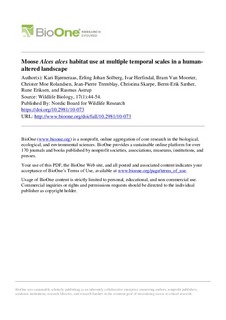| dc.contributor.author | Bjørneraas, Kari | |
| dc.contributor.author | Solberg, Erling Johan | |
| dc.contributor.author | Herfindal, Ivar | |
| dc.contributor.author | Van Moorter, Bram | |
| dc.contributor.author | Rolandsen, Christer Moe | |
| dc.contributor.author | Tremblay, Jean-Pierre | |
| dc.contributor.author | Skarpe, Christina | |
| dc.contributor.author | Sæther, Bernt-Erik | |
| dc.contributor.author | Eriksen, Rune | |
| dc.contributor.author | Astrup, Rasmus | |
| dc.coverage.spatial | Norway | nb_NO |
| dc.date.accessioned | 2018-06-05T12:17:58Z | |
| dc.date.available | 2018-06-05T12:17:58Z | |
| dc.date.created | 2010-11-05T09:45:35Z | |
| dc.date.issued | 2011 | |
| dc.identifier.citation | Wildlife Biology. 2011, 17 (1), 44-54. | nb_NO |
| dc.identifier.issn | 0909-6396 | |
| dc.identifier.uri | http://hdl.handle.net/11250/2500391 | |
| dc.description.abstract | Habitat alteration by humans may change the supply of food and cover for wild ungulates, but few studies have examined how these resources are utilised over time by individuals of different sex and reproductive status. We examined circadian and seasonal variation in habitat utilisation within a moose Alces alces population in central Norway. Our study area covers forests and open habitats, both influenced by human alterations (e.g. forestry and agriculture). We expected moose to select habitats with good forage and cover in all seasons, but to select open foraging habitats mainly during night-time. Moose selected good foraging habitats, such as young forest stands and cultivated land during night, whereas the utilisation of older forest stands providing cover increased during daytime. This circadian pattern changed throughout the year, seemingly related to variation in hours of daylight and provision of forage. Young forest stands provided higher density of preferred food plants compared to older stands and were highly selected from spring until autumn. Relative to young forest, the selection for older forest stands increased towards winter, likely due to provision of higher plant quality late in the growing season, and to reduced accumulation of movement-impeding snow during winter. Selection of cultivated land varied among seasons, being highest when crop biomass was high. We also found some indications of state-dependent habitat selection as reproducing females avoided open, food rich areas in the first months after their calves were born, whereas males and females without young selected these areas in spring and summer. Our results clearly show that moose exploit the variations in cover and food caused by forestry and agriculture. This is particularly relevant for moose in Norway as current changes in forestry practice lead to a reduction in young, food-rich forest stands, possibly aggravating the already declining body conditions and recruitment rates of moose. | nb_NO |
| dc.language.iso | eng | nb_NO |
| dc.publisher | Nordic Board for Wildlife Research | nb_NO |
| dc.rights | Navngivelse 4.0 Internasjonal | * |
| dc.rights.uri | http://creativecommons.org/licenses/by/4.0/deed.no | * |
| dc.subject | Alces alces | nb_NO |
| dc.subject | forest stage | nb_NO |
| dc.subject | habitat selection | nb_NO |
| dc.subject | moose | nb_NO |
| dc.subject | reproductive status | nb_NO |
| dc.subject | step selection function | nb_NO |
| dc.subject | ungulates | nb_NO |
| dc.title | Moose Alces alces habitat use at multiple temporal scales in a human-altered landscape | nb_NO |
| dc.type | Journal article | nb_NO |
| dc.type | Peer reviewed | nb_NO |
| dc.description.version | publishedVersion | nb_NO |
| dc.rights.holder | © Wildlife Biology, NKV | nb_NO |
| dc.source.pagenumber | 44-54 | nb_NO |
| dc.source.volume | 17 | nb_NO |
| dc.source.journal | Wildlife Biology | nb_NO |
| dc.source.issue | 1 | nb_NO |
| dc.identifier.doi | 10.2981/10-073 | |
| dc.identifier.cristin | 347353 | |
| dc.relation.project | Norges forskningsråd: 183759 | nb_NO |
| cristin.ispublished | true | |
| cristin.fulltext | original | |
| cristin.qualitycode | 1 | |

